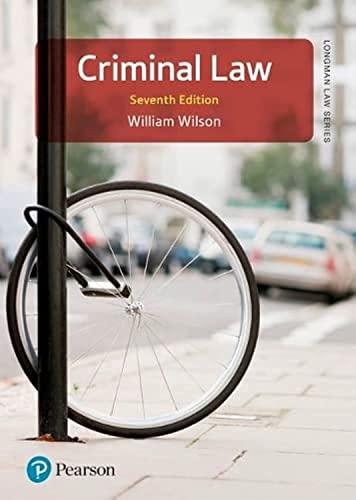Question
The case study is Salib v. City of Mesa [1]. Facts: Edward Salib owned a Winchell's Donut House in Mesa, Arizona. Salib displayed large signs
The case study is Salib v. City of Mesa[1]. Facts: Edward Salib owned a Winchell's Donut House in Mesa, Arizona. Salib displayed large signs in his store window. The City ordered Salib to remove the characters as they violated the Sign Code, which prohibited covering more than 30% of the store's windows with signs. Salib sued to claim the Sign Code violated his First Amendment rights. The trial court ruled in favor of Mesa, and Salib appealed. Using the IRAC method of case analysis, please analyze this case. The court will answer the problem if the government is the legal principle(s). Next, read the Holding of the case below, then complete the following exercise. Holding:The trial court ruling is affirmed. The First Amendment does not protect commercial speech that concerns any unlawful activity or false or misleading. However, all other speech may be regulated if the government can satisfy a three-prong test. First, the government must show a substantial interest in supporting the regulation. Both parties agree that aesthetics is of considerable interest. Second, the government must show that the challenged regulation advances that interest directly and materially. Here Salib argues that Mesa cannot satisfy this prong because they have conducted no studies proving what aesthetic or safety problem existed and how the Sign Code could solve such problems. Mesa claims that the Sign Code was passed in response to legitimate concerns of business owners that many businesses in the area had 100% window coverage and that detracted from the aesthetic of the City. Moreover, the city council received considerable input on sign coverage of windows before passing the Code. The constitution does not require studies to show that the regulation's interests are being advanced. Lastly, Salib argues that the Sign Code is not narrowly tailored. However, narrowly tailored does not mean that the least restrictive means must be used to accomplish the City's goals. A "reasonable fit" between the intent of the law and the means used to achieve that intent is sufficient. Mesa claims that 30% is a reasonable compromise between 100% coverage and a total ban on signage. The court is not in a position to determine what percentage of coverage is the best solution, only that the 30% standard adopted by the City was reasonable to fulfill the Code's goals.
Highlight the text that demonstrates the court's analysis of the case in a color of your choice.
Underline the text that illustrates the rule of law in this case. Highlight the text that illustrates the court's analysis of the case in a color of your choice.
Step by Step Solution
There are 3 Steps involved in it
Step: 1

Get Instant Access to Expert-Tailored Solutions
See step-by-step solutions with expert insights and AI powered tools for academic success
Step: 2

Step: 3

Ace Your Homework with AI
Get the answers you need in no time with our AI-driven, step-by-step assistance
Get Started


